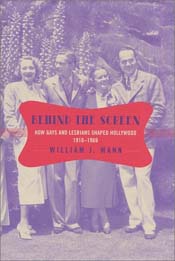 |
|
Courtesy of The Letter Behind the Screen: How Gays and Lesbians Shaped Hollywood 1910-1969 by William J. Mann. New York: The Penguin Group (Viking), 2001. ISBN 0-670-03017-1. 422 pages hardback, $29.95.  There have been many biographies and histories written about gay and lesbian
movie stars. By now we all should know about Tyrone Power, Marlene Dietrich,
and Tony Perkins, among numerous others.
There have been many biographies and histories written about gay and lesbian
movie stars. By now we all should know about Tyrone Power, Marlene Dietrich,
and Tony Perkins, among numerous others.
But the public has always suspected there were many more of us behind the scenes manipulating those images on the silver screen. Now the truth has been revealed. Behind the Screen, by the ruggedly handsome William J. Mann, is a thoroughly documented investigation into the influences gay men and lesbians have had on the movies. Pouring through thousands of obituaries to find tell-tale language that might lead him to suspect the deceased was gay or lesbian, Mann has uncovered a small city of homosexuals, many of whom no one had suspected were gay or lesbian until now. Because many of them-or their lovers and friends--are still living, he was able to track them down and obtain some remarkable primary information, including oral histories, old letters, newspaper clippings, and photographs. The main question is: how much did their "gay sensibility" influence the way movies were made? Outside such departments as costume and set design, such an ephemeral quality is hard to pinpoint. How can you tell, for example, if an editor's gayness altered the way a movie looked? Some jobs, of course, lent themselves better to "gay sensibility" than others, but Mann makes a convincing case for how their outsider status forced most gays and lesbians to see the world a little differently. While Hollywood was a generally comfortable place for them to work and live, they still weren't totally accepted: it's a small town. Such a milieu, he feels, helped keep their artistry and craftsmanship on edge, most notably in the artistic departments.
Perhaps Mann's most interesting discovery is the way homosexuality and Communism became wedded in the minds of the McCarthyites after World War II. He points out that a 1945 labor strike was inaugurated by several gay men (though its leadership was later taken over by straights). After it ended, anti-Communist crusaders began looking at gays' general involvement in Hollywood. The result: the great homo-pinko scares of the late 40s and early 50s which eventually infected the entire federal government. Mann has done good groundwork there. A more thorough, book-length investigation is definitely warranted. Mann's book isn't for the amateur stargazer. This is in-depth history. Behind the Screen is a fascinating look at a part of Hollywood that's been oddly overlooked until now. The serious reader will be well rewarded. |

